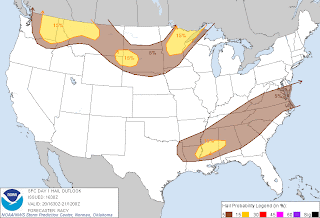Well, now that the low pressure
system has finally begun to fire storms over the Puget Sound, they will be
moving North/ North East by this afternoon. Our chase day so far has started
off with lighting outside our window and torrential rains that just do not seem
to want to go away. As I stated yesterday, the storms of the Central Cascades
region will begin to develop from 18z to 19z, so that gives us our time to pack
and prepare the vehicle. Because supercells become more likely from 4 to 7pm,
we shall be leaving our current location around 3pm.
 |
| {SPC Friday Tornado Outlook} |
This
morning the SPC had released their severe weather outlook, giving our targeted
area a 2% chance of seeing a tornado (and that is as good as it gets throughout
the entire nation) within fifteen miles of any given point. This is due to
sufficient shear standing at thirty to fifty knots and large CAPE of 1000+
J/km.
 |
| {SPC FridaySevere Hail Outlook} |
 |
| {SPC Friday Severe Wind Outlook} |
At this moment the SPC has issued their current mesoscale discusion...
MESOSCALE
DISCUSSION 1513
NWS STORM PREDICTION CENTER NORMAN OK
1132 AM CDT FRI JUL 20 2012
AREAS AFFECTED...PARTS OF NE OREGON/ERN WASHINGTON AND ADJACENT
NWS STORM PREDICTION CENTER NORMAN OK
1132 AM CDT FRI JUL 20 2012
AREAS AFFECTED...PARTS OF NE OREGON/ERN WASHINGTON AND ADJACENT
IDAHO
CONCERNING...SEVERE POTENTIAL...WATCH
POSSIBLE
VALID 201632Z - 201800Z
PROBABILITY OF WATCH ISSUANCE...60 PERCENT
SUMMARY...TRENDS ARE BEING MONITORED FOR AN
INCREASING SEVERE THREAT
THAT COULD REQUIRE A WATCH BY EARLY
AFTERNOON.
DISCUSSION...MID-LEVEL FLOW STILL APPEARS
GENERALLY SUBSIDENT ALONG THE EASTERN FRINGE OF A 50-60 KT SOUTHERLY
500 MB JET STREAK LIFTING THROUGH EASTERN OREGON AND WASHINGTON. BUT CLEAR TO PARTLY CLOUDY CONDITIONS ARE ALLOWING FOR CONSIDERABLE INSOLATION...AND DESTABILIZATION OF A MOIST BOUNDARY LAYER
ACROSS THE WALLOWA/BLUE MOUNTAINS VICINITY NORTHWARD THROUGH MUCH OF
THE COLUMBIA BASIN. LATEST OBJECTIVE ANALYSES AND MODEL
FORECASTS SUGGEST THAT CAPE IS IN THE PROCESS OF BECOMING MODERATELY
LARGE...ON THE ORDER OF 1000 TO 2000 J/KG...AND THIS IS EXPECTED TO
BECOME SUPPORTIVE OF VIGOROUS CONVECTIVE DEVELOPMENT AS MID-LEVEL FORCING
FOR ASCENT INCREASES AHEAD OF AN UPPER TROUGH BEGINNING TO LIFT
NORTHEAST OF THE CASCADES.
GUIDANCE INDICATES STORM DEVELOPMENT MAY INITIATE AS EARLY AS 18-19Z...BEFORE INCREASING IN
COVERAGE/INTENSITY DURING THE AFTERNOON.
VERTICAL SHEAR WILL BE MORE THAN SUFFICIENT FOR SUPERCELLS WITH AT LEAST A RISK FOR LARGE
HAIL AND LOCALLY DAMAGING WIND GUSTS.
LOW-LEVEL HODOGRAPHS ARE MORE UNCERTAIN...BUT AN ISOLATED TORNADO MAY NOT BE OUT OF THE
QUESTION...PARTICULARLY EAST OF THE SURFACE LOW...NEAR/NORTH OF THE
YAKIMA VALLEY.




